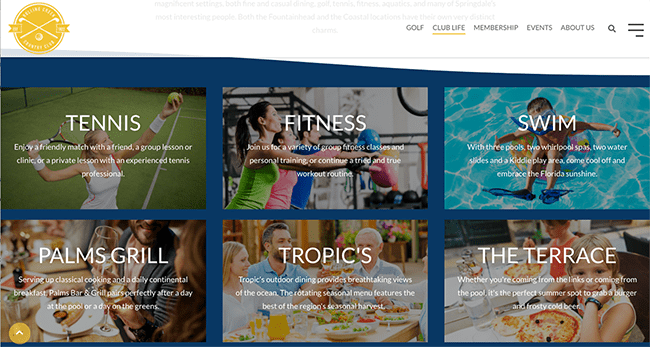Drive Club Membership: 3 Lead Generation Strategies for Your Website
Private clubs pride themselves on being the best when it comes to customer service and community. But there's one way that you might be failing to...
In the long history of club marketing, websites are a fairly new tool. Think about it, when did you realize that your club needed a website? 2005? 2010? 2015? Chances are, you’ve seen your website evolve, especially as it concerns engagement on the member side of your platform.
Most clubs tend to view the back end of their website as the primary reason for their website. Operational functions, member communication and directories, tee times, event sign-up, and accounting are typically some of the primary “back end” features of a club’s website.
On the other hand, the public-facing side of the website has often been viewed as an online brochure—providing basic information about the club with beautiful images. Clubs that are still of this mindset are not giving prospective members what they’re looking for when they’re considering joining.
Modern websites that are public-facing can increase productivity for your team, reduce the workload of membership directors, and drive prospective members 24 hours a day, 7 days a week. Your website can be the most valuable part of your membership team. What if your membership director was only spending time working with qualified members instead of every tire-kicking applicant looking for a free round of golf? And what if you were able to respond to interested member prospects even when the club was closed? Best of all, what if a more dynamic, public-facing website could work seamlessly with your current back-end web platform, potentially utilizing tools like HubSpot for private clubs?
“Your website must gather information about prospects along the way,” says Lisa Schmidtke, Director of Web Development at StoryTeller, “This includes website visitors who are not ready to reach out and become members. They might not even be ready to receive pricing and all the information that they need. But there are certain pieces of content that websites and clubs can offer for those just "kicking the tires."
Schmidtke has extensive experience in developing websites for more than 20 years. She’s also a private club member who has noticed an interesting aspect of private clubs and their websites—they often feature pictures that do not include people. And yet, club leaders often say their membership is what makes their club unique.
“The images, copy, graphics, and design should all entice prospects so they can actually see themselves at the club and envision what it would be like to be a member there,” says Schmidtke. When website visitors see pictures of members and their families they begin to imagine themselves at the club. They can evaluate, instinctively, whether they will feel comfortable—an important part of attracting potential members to your club.
Downloadable items on the public-facing website, like a Membership Guide or a club programming guide, can provide prospective members with information to help them determine whether your club is right for them. Additionally, it provides your membership team with a new prospective contact with minimal time investment on their part. If the prospect is qualified, the membership director can reach out to arrange a tour.
An updated public-facing website not only aids engagement but also helps your club get discovered by prospective members who might not be aware of your existence. Optimizing your website for organic search ensures that search engines recognize your club's offerings, attracting individuals new to the area or club life. Being a top result on Google is invaluable, especially when potential members seek information at any time of the day.
“In the digital age, immediacy is key,” Schmidtke adds. “Prospective members prefer finding information at their fingertips without the need for phone calls or waiting. A modern, mobile-responsive website with optimized search capabilities caters to these expectations, removing barriers to entry for potential members, especially the younger generation.”
While some of these practices and capabilities are typically not found on private club websites, this is standard practice for most businesses. Modern websites that are mobile responsive, and optimized for search with content and images that tell the story of an organization are commonplace in business today. Your prospective members expect your club to have a modern website with robust capabilities—it’s what they have become accustomed to in the world today. It’s how they do business.
Like many businesses, private clubs are trying to do more with less. Digital marketing is complex and multi-channel. Sound club marketing strategy begins with a website built to attract and engage visitors, whether that person is on their phone, reading a tablet, or working on their laptop on a Sunday night. If the public-facing part of your website isn’t built to engage prospective members you may be missing out on new member opportunities and impeding the productivity of your membership team.

Private clubs pride themselves on being the best when it comes to customer service and community. But there's one way that you might be failing to...

Editors note: this 2021 blog was updated in 2023 to include additional resources.

The next generation private club member — your future looks pretty slim without them, yet your current marketing strategy just isn't delivering...